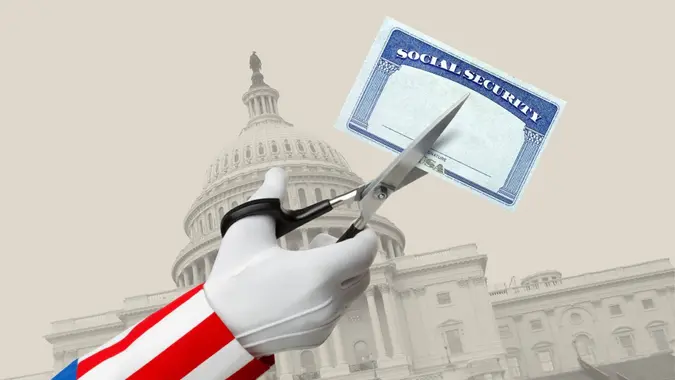What a Middle-Class Social Security Check Could Look Like in 2025

Commitment to Our Readers
GOBankingRates' editorial team is committed to bringing you unbiased reviews and information. We use data-driven methodologies to evaluate financial products and services - our reviews and ratings are not influenced by advertisers. You can read more about our editorial guidelines and our products and services review methodology.

20 Years
Helping You Live Richer

Reviewed
by Experts

Trusted by
Millions of Readers
With the current election cycle and the continued focus on issues like inflation and the national debt, many people are wondering what will happen with Social Security.
While it’s hard to predict what will happen in the long term — and much could change depending on factors such as who wins the election and what happens with the economy — looking at short-term changes to Social Security is generally more straightforward. That’s because Social Security benefit increases follow a formula known as a cost-of-living adjustment (COLA).
How COLA Works
Each year, Social Security gets a COLA, except in the rare years that essentially have no inflation — though benefits never decrease, even during periods of deflation.
The COLA is based on the increase, if any, of the Consumer Price Index for Urban Wage Earners and Clerical Workers (CPI-W). However, the calculation specifically compares the third-quarter average of the CPI-W to the third quarter of the previous year (assuming there was a COLA then as well).
So, in December 2023, for example, there was a COLA of 3.2%, based on the CPI-W increase in the third quarter of 2023 compared to the third quarter of 2022. Note that while the change is effective as of Dec. 1, Social Security recipients don’t see the change until they receive benefit payments at the start of January.
This year, the COLA will be determined by how much the CPI-W increases in the third quarter of 2024 compared to the third quarter of 2023, so that is still underway, as the quarter runs through September. The Bureau of Labor Statistics is scheduled to release this inflation data on Oct. 10, and the Social Security Administration is expected to follow suit with announcing the official COLA increase for 2025.
How Much Will Social Security Benefits Increase in 2025?
Although recent inflation data has shown signs of moderating, there’s still likely to be some inflation in the third quarter of 2024 that will affect Social Security checks in 2025. The latest projection from The Senior Citizens League is that the 2025 COLA will be 2.63%.
Although this smaller increase compared to last year reflects lower inflation, it might not be enough for many seniors who rely on Social Security income. As The Senior Citizens League points out, certain categories such as groceries and healthcare sometimes increase faster than the overall inflation rate, so the COLA doesn’t always help seniors keep up with the increased cost of living.
Plus, many seniors who rely primarily on Social Security aren’t earning much in the first place.
On average, a Social Security recipient receives $1,781 per month, as of mid-2024, according to the Social Security Administration. The average Social Security benefit for retired workers (as opposed to survivor benefits, for example) is a little higher: $1,918.
If the 2025 COLA is 2.63%, based on The Senior Citizens League projection, that could mean a middle class Social Security check for a retiree increases by about $50.
Consider how a healthy 65-year-old can expect to spend around $5,700 per year ($475 per month) on out-of-pocket healthcare, according to RBC. Add in costs like groceries, and it’s easy to see why many seniors are struggling to make ends meet when relying on Social Security alone. Indeed, about one-third of seniors said they visited a food pantry or applied for food stamps within the past year, according to a survey from The Senior Citizens League.
Granted, many middle-class retirees have other sources of retirement income to rely on, such as withdrawing from a 401(k) or IRA. But if you don’t have a retirement portfolio or other ways of generating retirement income, it’s important to consider how Social Security adjustments alone might not be enough to cover your bases.
 Written by
Written by  Edited by
Edited by 























